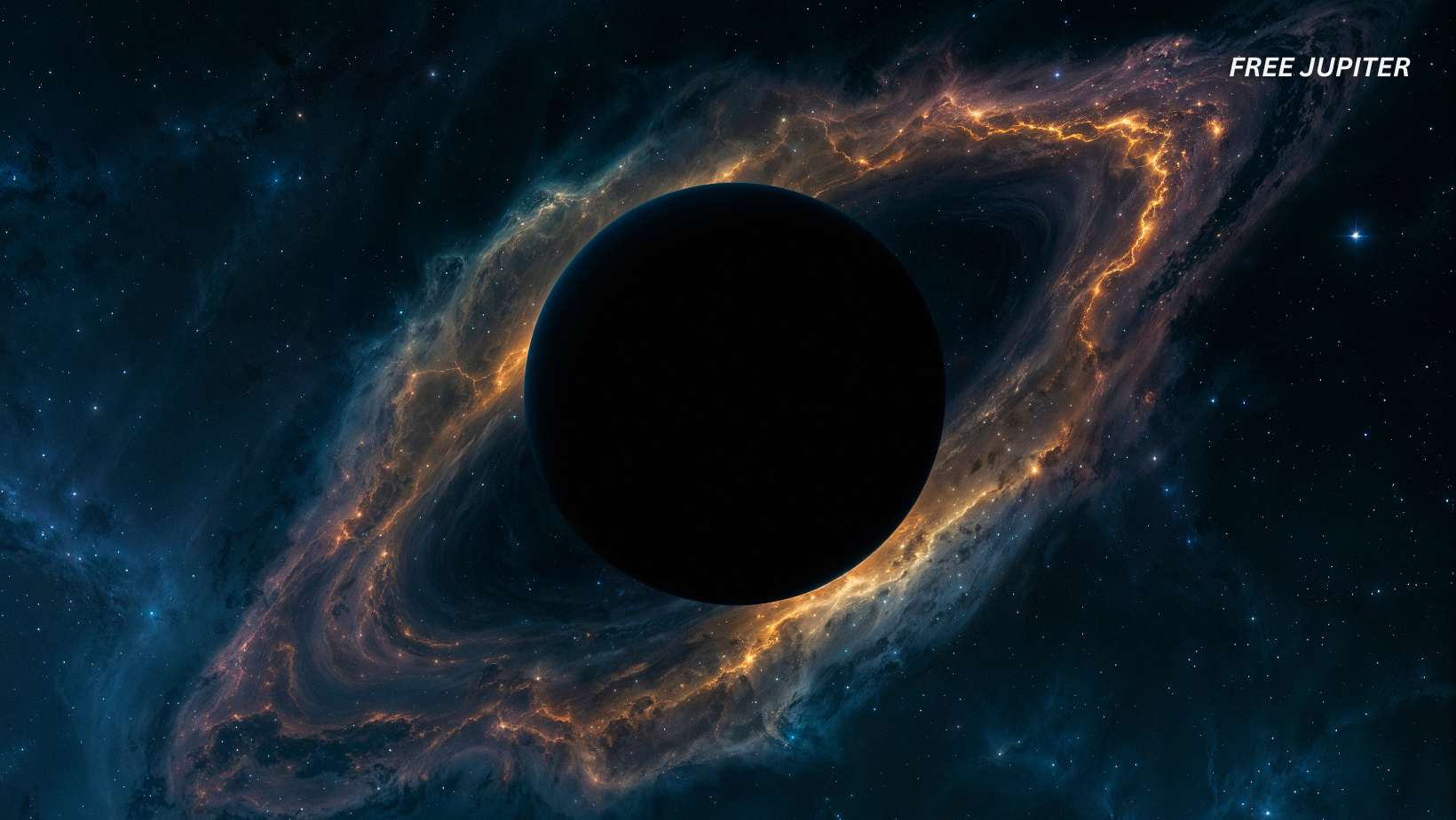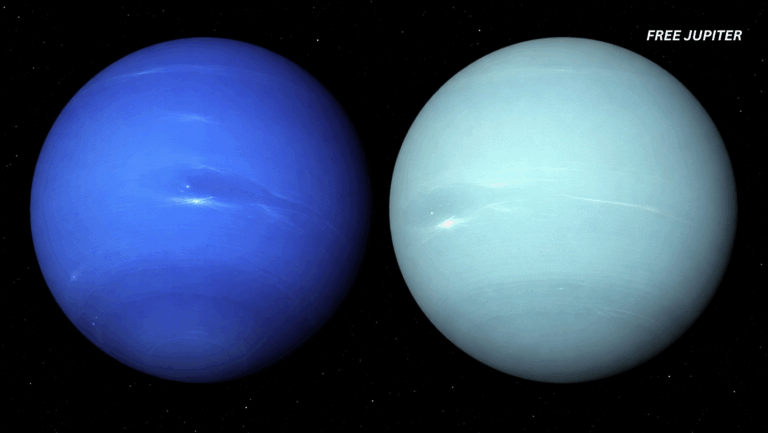Friendly Note: FreeJupiter.com shares general info for curious minds 🌟 Please fact-check all claims—and always check health matters with a professional 💙
Imagine a cosmic object so heavy it could swallow our entire solar system—and still be hungry. That’s what astronomers think they’ve just discovered: a black hole so enormous it tips the scales at a staggering 36 billion times the mass of our Sun.
That’s not just big—it’s in a league of its own. And what’s more? It was found not by accident, but by carefully decoding one of the universe’s most spectacular illusions: a cosmic mirage called gravitational lensing.
This record-breaking black hole lies more than six billion light-years from Earth, nestled deep in the heart of a massive galaxy called LRG 3-757. The galaxy itself is part of a fascinating celestial alignment known as the Cosmic Horseshoe, which played a key role in helping scientists locate and weigh this astronomical behemoth.
Let’s Talk About the Cosmic Horseshoe—Nature’s Funhouse Mirror in Space
Back in 2007, astronomers spotted something remarkable—a ring-shaped halo of light that looked like it belonged in a galactic rodeo. Dubbed the Cosmic Horseshoe, this formation is a textbook case of gravitational lensing.
So, what exactly is that?
Gravitational lensing happens when the immense gravity of a foreground object—like a massive galaxy—bends and magnifies the light from something behind it. It’s Einstein’s theory of general relativity in action.
Think of it as nature’s own telescope: instead of using glass lenses, it uses gravity itself to warp space and redirect light.
In the case of the Cosmic Horseshoe, the foreground galaxy LRG 3-757 sits directly in the line of sight between Earth and a more distant galaxy behind it. The result? A beautiful luminous arc—almost a full circle—of light known as an Einstein Ring.
But that wasn’t just a pretty sight—it was a clue.
LRG 3-757: A Galaxy With Hidden Depths
LRG 3-757 is what astronomers call a luminous red galaxy—a giant elliptical type that shines brightly in infrared light but doesn’t form many new stars.
That tells us this galaxy is mature and well-aged, like a fine wine in a dusty bottle. It’s also enormous, boasting a mass roughly 100 times greater than the Milky Way.
And right at its center sits the main attraction: an ultramassive black hole, the kind of cosmic object so extreme, even light can’t escape its grip.
Read more: European Spacecraft Captures First-Ever Images of the Sun’s South Pole!
Measuring the Unmeasurable: How Do You Weigh a Black Hole From Six Billion Light-Years Away?
Here’s the thing about black holes—they’re invisible. They don’t emit light, they don’t sparkle, and they can’t be seen directly. So how do scientists know how heavy one is?
Usually, they estimate a black hole’s mass by watching how fast nearby stars and gas clouds move. If something’s zipping around really fast, it’s probably being tugged on by something massive and invisible—like a black hole.
But at over five billion light-years away, getting that kind of data is tricky. So the research team, led by Carlos R. Melo-Carneiro at Brazil’s Federal University of Rio Grande do Sul, turned to some of the best tools in modern astronomy.
They used the Multi Unit Spectroscopic Explorer (MUSE) instrument on the Very Large Telescope in Chile (yes, that’s its actual name) and paired it with ultra-clear images from the Hubble Space Telescope. This combo allowed them to create a detailed map of the galaxy’s mass distribution.
By analyzing how the background galaxy’s light was bent—and by studying how stars within LRG 3-757 were moving—they built a precise model of both the galaxy and the black hole at its core.
The result? A mind-boggling estimate: 36 billion solar masses. That’s one of the largest black hole masses ever measured directly.
Why This Black Hole is an Astrophysical Rebel
Black holes usually follow certain cosmic “rules.” One of them is known as the MBH–σe relation, which says that the heavier a black hole is, the faster the stars around it should be moving. It’s a predictable relationship seen in thousands of galaxies.
But not this time.
Based on how fast the stars are moving in LRG 3-757—about 366 kilometers per second—the black hole should be much smaller. Instead, it’s about 1.5 standard deviations above what scientists expected. That makes it an outlier, a cosmic oddball that defies the usual galactic recipe.
So, how did it get this way?
How Do You Make a Black Hole This Big?
There are a few possibilities, and none of them are boring.
- Galactic Mergers
One theory is that LRG 3-757 has gone through a series of galactic smash-ups. When galaxies collide, their central black holes often merge as well. Over time, this can lead to a bloated, ultramassive black hole. During these violent events, stars are flung out from the core, which could explain why the black hole is huge even if the stars around it aren’t moving unusually fast. - AGN Feedback
Black holes don’t just eat—they burp. When actively consuming matter, they can spew energy back into their surroundings in a process called AGN feedback. This can stop new stars from forming and alter the structure of the galaxy. It’s possible this feedback gave the black hole room to grow while the rest of the galaxy stayed relatively quiet. - A Relic of a Quasar Past
Another idea is that this black hole is a fossil from the early universe—a remnant of a time when it blazed as a quasar, rapidly devouring gas and dust in its youth. In this scenario, the black hole grew fast and early, long before its host galaxy settled down into a quieter life.
Read more: The ‘City-Killer’ Asteroid Is Now Even More Likely to Hit The Moon in 2032
Why This Discovery Matters
What makes this black hole so remarkable isn’t just its size—it’s when we’re seeing it.
The light from the Cosmic Horseshoe took more than four billion years to reach us. That means we’re looking at a snapshot from the universe’s past, during a time when galaxies were still evolving rapidly.
And yet, even at this early stage, LRG 3-757 already had one of the most massive black holes we’ve ever measured.
This challenges our current models of how galaxies and black holes grow together. If black holes can become this massive so early, scientists may need to rethink how quickly—and under what conditions—these cosmic giants form.
Read more: Voyager Probes Stumble Upon a Cosmic ‘Wall of Fire’ Outside Of Our Solar System
A New Era of Cosmic Sleuthing Begins
This isn’t a one-time event. Far from it. With new space missions like Euclid now scanning the skies, astronomers expect to find hundreds of thousands of gravitational lensing systems just like the Cosmic Horseshoe in the coming years.
And with next-gen observatories like the Extremely Large Telescope (ELT) on the way, they’ll be able to measure star movements in distant galaxies with razor-sharp precision. This will open the door to discovering even more record-breaking black holes.
Each new find will help piece together the grand story of how galaxies—and the monsters at their cores—came to be.
As Melo-Carneiro and his team noted, “We are entering a new phase of discovery,” one that could rewrite our understanding of the universe’s earliest, most powerful forces.
The full study is available on the open-access platform arXiv, where scientists share their latest cosmic detective work.










